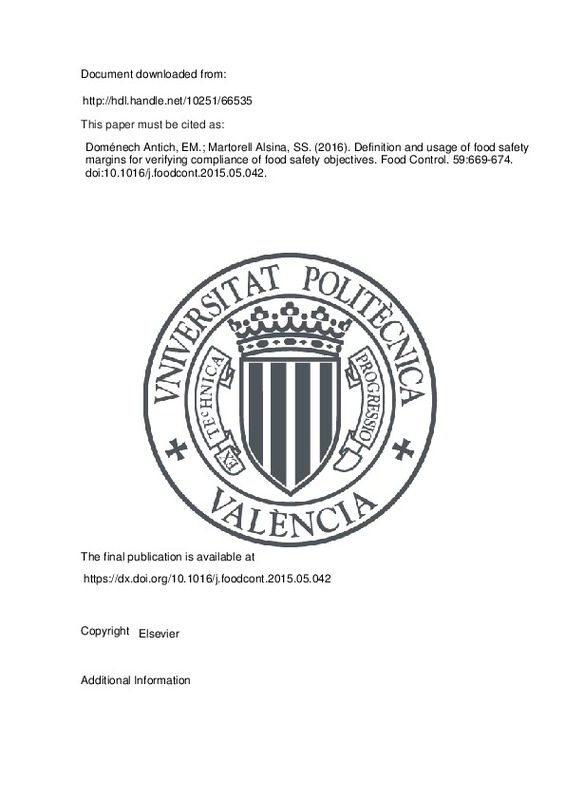JavaScript is disabled for your browser. Some features of this site may not work without it.
Buscar en RiuNet
Listar
Mi cuenta
Estadísticas
Ayuda RiuNet
Admin. UPV
Definition and usage of food safety margins for verifying compliance of food safety objectives
Mostrar el registro sencillo del ítem
Ficheros en el ítem
| dc.contributor.author | Doménech Antich, Eva Mª
|
es_ES |
| dc.contributor.author | Martorell Alsina, Sebastián Salvador
|
es_ES |
| dc.date.accessioned | 2016-06-27T11:42:22Z | |
| dc.date.available | 2016-06-27T11:42:22Z | |
| dc.date.issued | 2016-01 | |
| dc.identifier.issn | 0956-7135 | |
| dc.identifier.uri | http://hdl.handle.net/10251/66535 | |
| dc.description.abstract | [EN] Over the last decade, risk analysis has gradually been introduced as a tool to make decisions about food safety policies. In this framework, the ALOP (Appropriate Level of Protection) concept, which can be seen as a statement of the degree of public protection that should be attained in a country, was introduced. In addition, FSO (Food Safety Objectives) was introduced to provide a link between the ALOP and target points/goals in the supply chain. Historically, ALOP and FSO decisions have been based on the ALARA (As Low As reasonably Achievable) approach. Since an ALARA approach is based on the status of current technology, it is likely that the ALOP is attainable, provided a substantial portion of the industry complies with technological requirements or adopt “best practices” that will achieve the FSO. Food managers must control and government agencies must enforce and monitor the fulfilment of FSO. Once FSO has been established and adopted by the food industry, a major concern is to evaluate the results of the implementation of FSO in order to verify compliance. This paper introduces the concept of food safety margin (FSM) and its formulation based on classical and probabilistic approaches, which are intended to be used as a tool to measure the degree of compliance with FSO. For a better understanding of how food safety margins perform, FSM are estimated for Listeria monocytogenes in three different products, (semi-soft cheese, heat treated meat and cold smoked salmon). The results obtained, adopting both classical and probabilistic approaches, are discussed. | es_ES |
| dc.language | Inglés | es_ES |
| dc.publisher | Elsevier | es_ES |
| dc.relation.ispartof | Food Control | es_ES |
| dc.rights | Reserva de todos los derechos | es_ES |
| dc.subject | Risk management | es_ES |
| dc.subject | Exposure assessment | es_ES |
| dc.subject | FSO | es_ES |
| dc.subject.classification | TECNOLOGIA DE ALIMENTOS | es_ES |
| dc.subject.classification | INGENIERIA NUCLEAR | es_ES |
| dc.title | Definition and usage of food safety margins for verifying compliance of food safety objectives | es_ES |
| dc.type | Artículo | es_ES |
| dc.identifier.doi | 10.1016/j.foodcont.2015.05.042 | |
| dc.rights.accessRights | Abierto | es_ES |
| dc.contributor.affiliation | Universitat Politècnica de València. Departamento de Ingeniería Química y Nuclear - Departament d'Enginyeria Química i Nuclear | es_ES |
| dc.contributor.affiliation | Universitat Politècnica de València. Departamento de Tecnología de Alimentos - Departament de Tecnologia d'Aliments | es_ES |
| dc.description.bibliographicCitation | Doménech Antich, EM.; Martorell Alsina, SS. (2016). Definition and usage of food safety margins for verifying compliance of food safety objectives. Food Control. 59:669-674. doi:10.1016/j.foodcont.2015.05.042 | es_ES |
| dc.description.accrualMethod | S | es_ES |
| dc.relation.publisherversion | https://dx.doi.org/10.1016/j.foodcont.2015.05.042 | es_ES |
| dc.description.upvformatpinicio | 669 | es_ES |
| dc.description.upvformatpfin | 674 | es_ES |
| dc.type.version | info:eu-repo/semantics/publishedVersion | es_ES |
| dc.description.volume | 59 | es_ES |
| dc.relation.senia | 292144 | es_ES |
| dc.identifier.eissn | 1873-7129 |







![[Cerrado]](/themes/UPV/images/candado.png)

